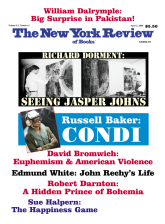In response to:
A Solution for the US–Iran Nuclear Standoff from the March 20, 2008 issue
To the Editors:
William Luers and his colleagues are to be commended for their proposal for a solution to the US–Iran nuclear standoff [NYR, March 20]. It should certainly be explored. Here are a few comments that might be helpful.
First let me say a bit about what they call the “P-2” centrifuge. The P-1 centrifuge, the predecessor of the P-2, is a modified version of the design the Iranians bought from A.Q. Khan, Pakistan’s covert salesman of nuclear know-how. The P-1 centrifuge consists of four short, thin aluminum cylindrical tubes connected by cylindrical joins called “bellows.” The bellows are made of what is known as “maraging steel”—a very strong and malleable alloy made without carbon. They were first introduced by German prisoners of war in the Soviet Union, who created the prototype modern centrifuge. They are designed to be sufficiently flexible to absorb some of the vibrations when the centrifuges are started up and brought to their working “peripheral velocity”—the speed of rotation on the outer edge—which in the case of the P-1 reaches 350 meters per second. The bellows are extremely difficult to design and manufacture. The Iranians had apparently been working on a design—the P-2—in which the rotors as well as the bellows were to be made with maraging steel.
But since the publication of The New York Review article, Iran has confirmed reports that it has started using a new centrifuge design, the IR-2, in which the rotors are made of carbon fiber. They can rotate much faster than the steel rotors. The capacity of separation of a given centrifuge depends both on the speed of rotation and the length of the cylinder. With the new design the speed is such that the rotor can be shortened so that no bellows are needed—a quantum leap in simplifying the technology and all the more reason why negotiations are now urgent.
The second point I want to call to your attention is a television interview given in Iran on April 12, 2006, by Gholam-Reza Aqazadeh, the head of Iran’s Atomic Energy Agency.* Who is Aqazadeh? He was born in 1948 in Khoy, a small city in Azerbaijan. He studied at Tehran University where he took degrees in mathematics and computer science. He had various positions in the government and in 1984 became the minister of oil. He served for twelve years and then was appointed to his current position. His interview, remarkable for its lucidity and candor, was given just after Iran had successfully tested its first cascade of 164 P-1 centrifuges in Natanz. As the authors of the Review’s article wrote, the Iranians have now connected eighteen of these cascades, using a total of about three thousand centrifuges.
Building these centrifuges wasn’t easy, as Aqazadeh explains:
In the preliminary stages of the work, we noticed that our machines broke down frequently. We couldn’t discover the cause, since we didn’t have any scientific sources or books to refer to. After great efforts we discovered that our experts didn’t wear fabric gloves during the assembly phase. We found out that when you assemble the parts with bare hands, germs are transferred to the machinery from the smallest amounts of sweat which comes off the hands…. Our young scientists are working day and night…. The manager for the injection stage is a distinguished graduate from one of the best universities in the country…. The manager said he had not been home for more than 2.5 months.
At the end of the interview Aqazadeh declares:
Our stance has always been that we are prepared to study any proposal by any country and negotiate with any country. But these negotiations must secure the interests of both sides and be objective. Proposals shouldn’t be politicized straight away because if they are, then nothing will be achieved…. I sincerely believe that if confidence has to be built in the world and it truly wants to be able to trust Iran’s activities, the best way, as our president has said, is to form partnerships. At this juncture, the best solution to this issue is for some of the concerned countries to become a partner in the activities at Natanz. There are opportunities for them to become a partner in the management, production, and technological sectors. This will create an atmosphere of trust. [Italics added.]
The time is long overdue for exploring these possibilities, as the authors of the Review article propose.
Jeremy Bernstein
Aspen, Colorado
William Luers, Thomas R. Pickering, and Jim Walsh reply:
We welcome Jeremy Bernstein’s useful comments. Berstein is a longtime and careful observer of nuclear technology in general, and Iran’s centrifuges in particular. As he points out, our article went to press just as reports were surfacing in the media concerning Iranian work on a modified P-2 centrifuge. The subsequent IAEA report made clear that, in fact, Iran was testing its first set of IR-2 centrifuges. We believe that this constitutes yet another piece of evidence demonstrating that Iran can build new (and better) centrifuges faster than the US can impose costs, and we agree with Bernstein that this new development gives further reason to consider a change in course. His reference to the Aqazadeh interview is especially relevant and noteworthy. It suggests Iranian openness to our proposal, but more importantly, it emphasizes a key and underappreciated reality of negotiations, namely, that both sides must get something out of the arrangement. Proposals that are all restrictions and no benefits are neither likely to succeed nor sustainable. We think our proposal allows all sides to move forward in a way that advances the goal of stopping the proliferation of nuclear weapons.
Advertisement
This Issue
April 3, 2008



